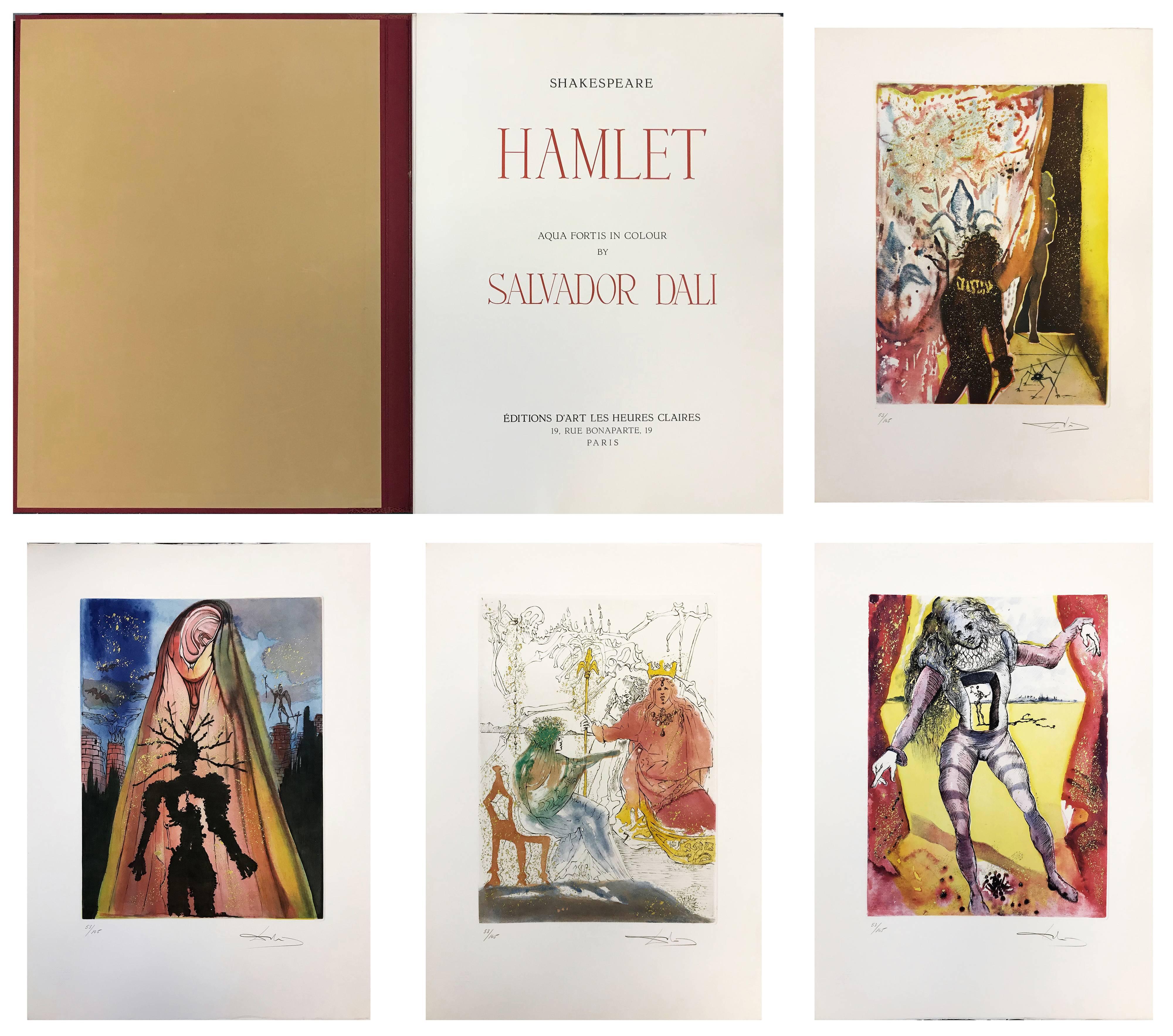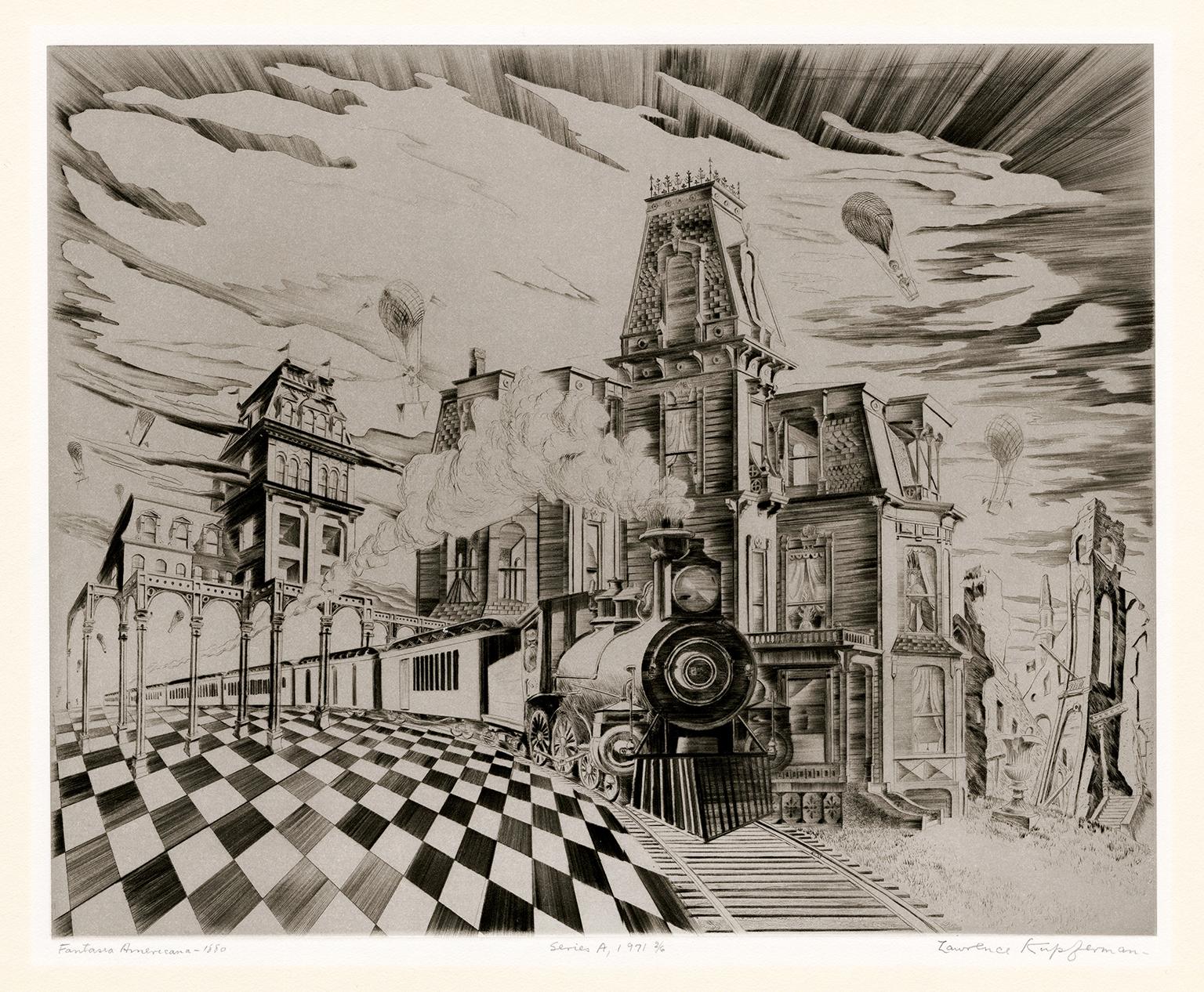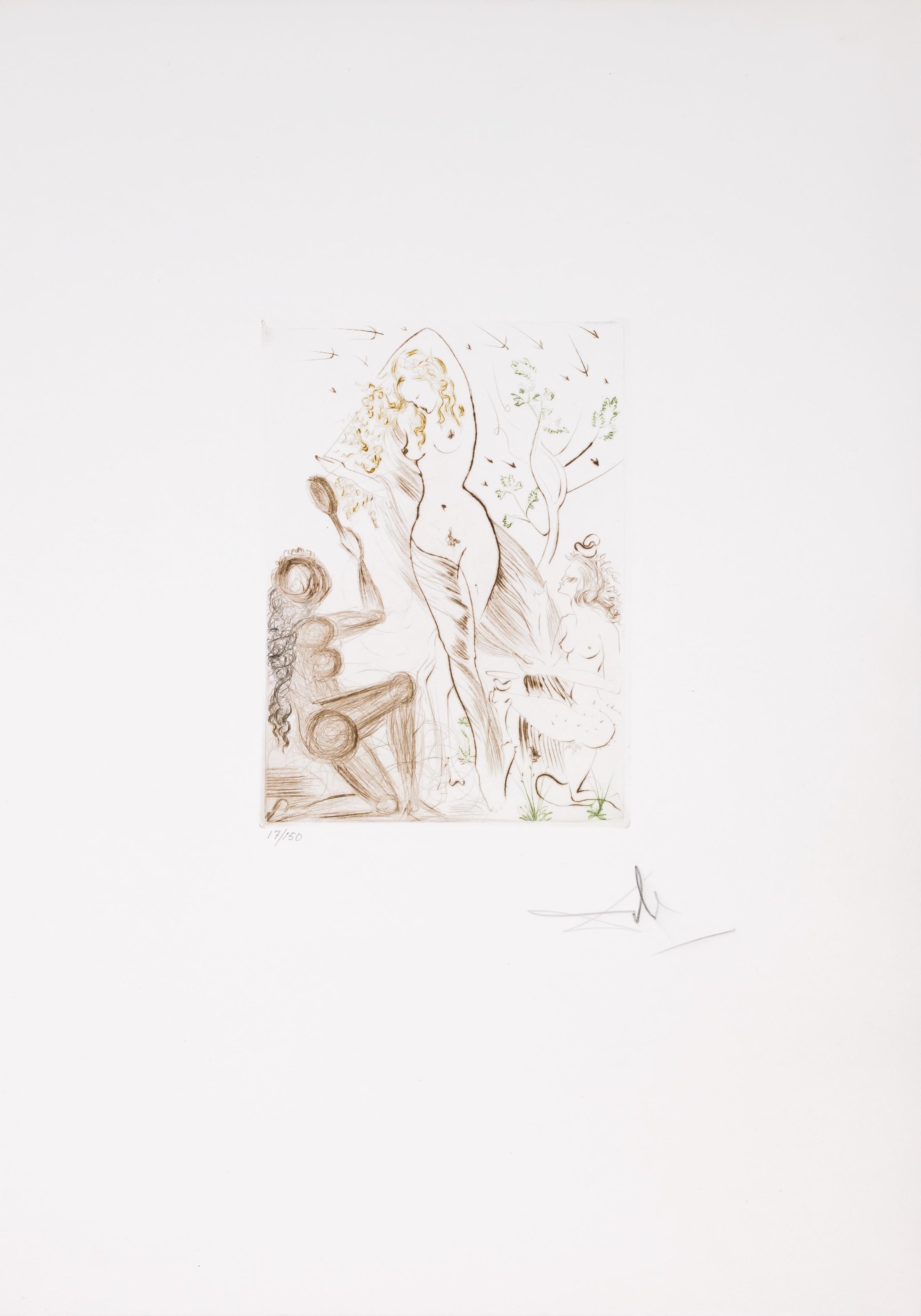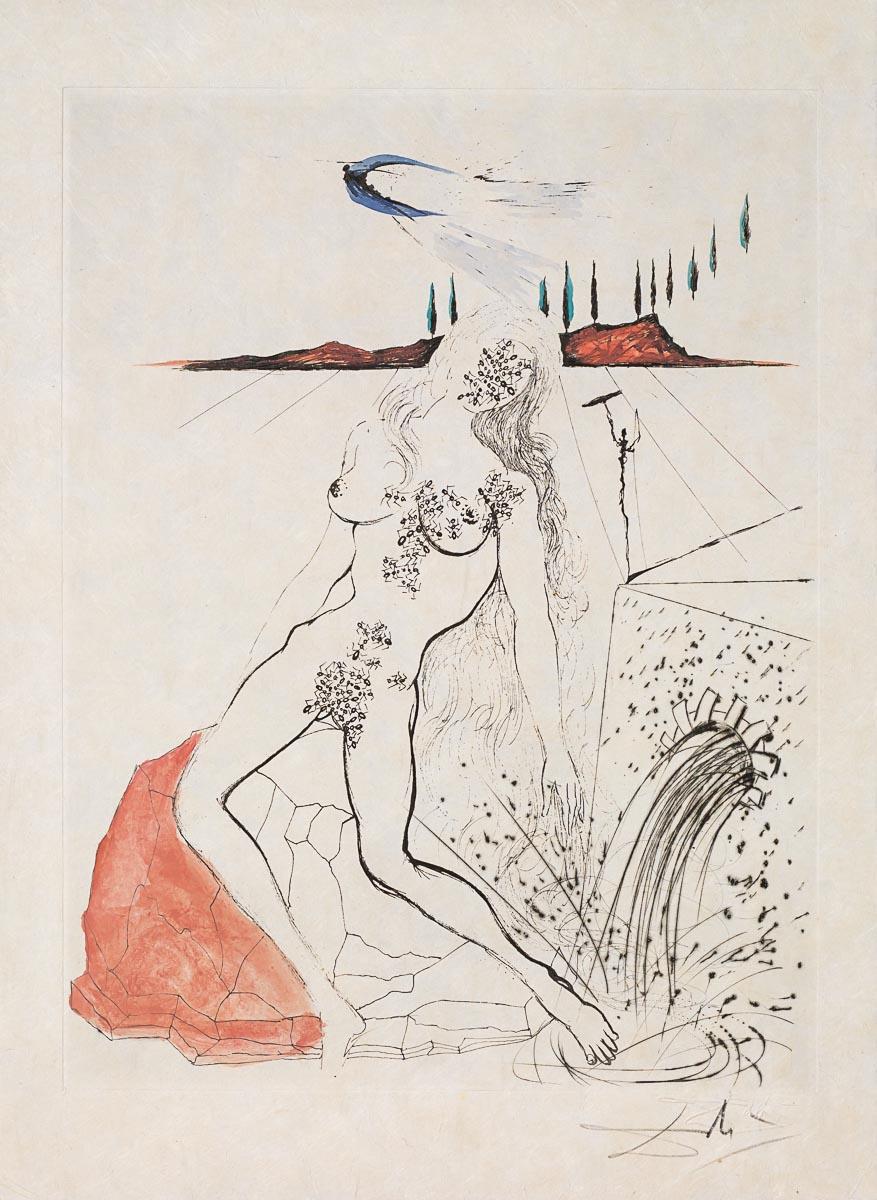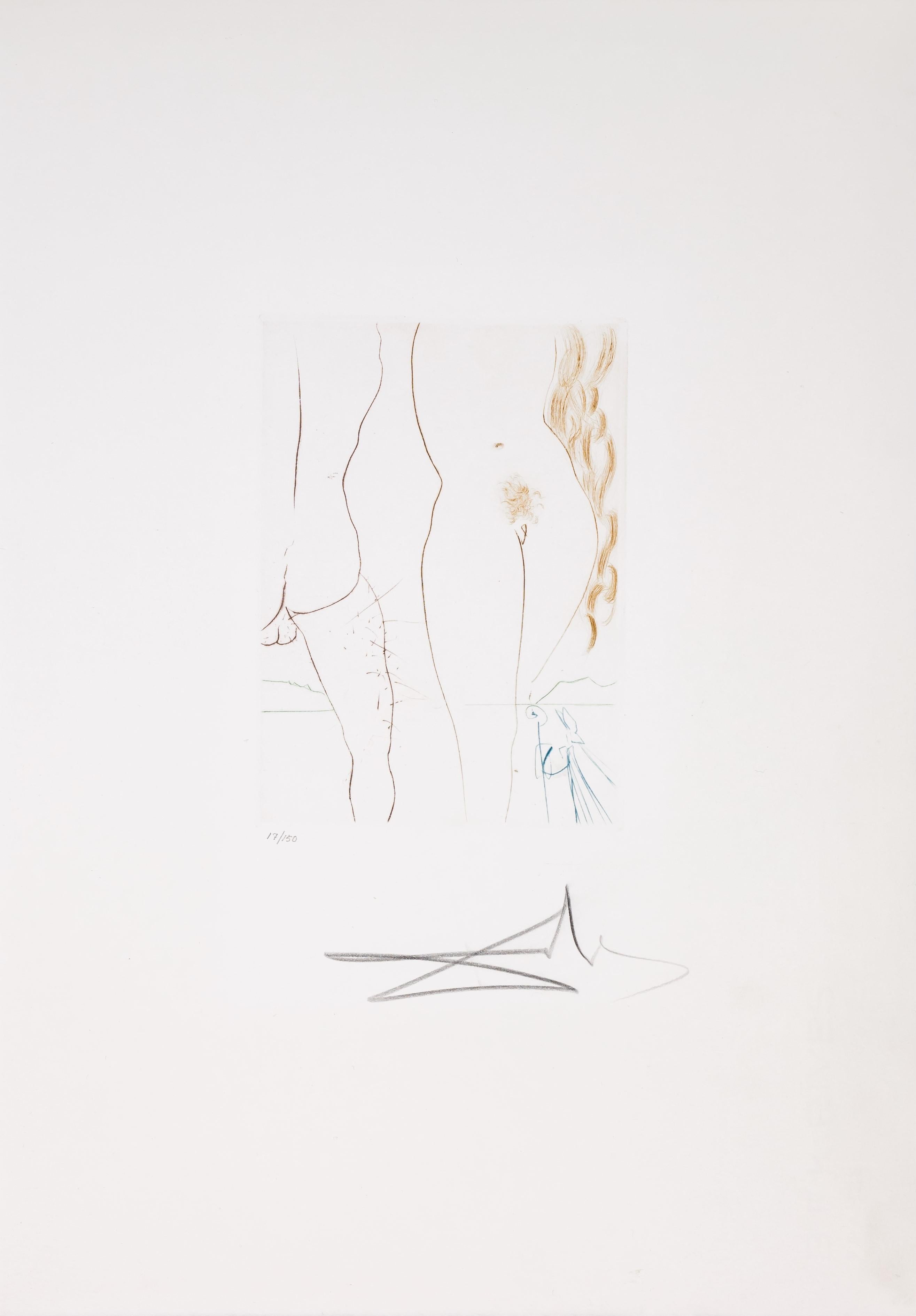Items Similar to The Web
Want more images or videos?
Request additional images or videos from the seller
1 of 6
Ray H. FrenchThe Web1950
1950
About the Item
The Web
Engraving and soft ground, 1950
Signed, titled, dated and numbered by the artist
Edition: 35 (26/35)
Printed by Master Printer, Jon Clemens, 2000
Provenance:
Estate of the artist
Martha A. French Trust
Note: Shows the artist's psychological struggles from post WWII and life as an artist
Condition: Excellent
Image: 10 3/4 x 7 1/4"
Sheet: 20 x 13 1/4";
Ray H. French: The Evolution of an Artistic Innovator
Printmaker, painter, and sculptor Ray H. French was born in Terre Haute, Indiana on May 16, 1919. Terre Haute was a cultural wasteland before the opening of the Sheldon Swope Art Museum in 1942. Thus, with a father as a coal miner and carpenter, art remained a luxury for Ray. Nevertheless, local art teachers Mabel Mikel Williams and Nola E. Williams helped to foster his creativity and unshakable drive to create things of beauty.
After high school, Ray attended the John Herron School of Art in Indianapolis. His studies there were interrupted by the outbreak of World War II, during which he developed surveillance photographs for the Army Air Force. After the war, Ray transferred to the University of Iowa on the G.I. Bill, where he received both his BFA and MFA degrees. The University of Iowa during the 1940s was a cultural mecca with many major art historians and artists. While in Iowa, Ray played an important role in this culture by becoming a founding member of the Iowa Print Group under Mauricio Lasansky.
Following his graduation in 1948, Ray experienced firsthand the rapid rise in creative printmaking in America. By 1949, he had exhibited at The Brooklyn Museum, the Walker Art Center, and MOMA New York. Ray’s early style of printmaking is characterized by pure line engraving on copper plates, a technique suited perfectly to his study of the beauty of animals. This charming and whimsical subject ran counter to the concurrent trends of Lasansky’s horrors of war and Hayter’s non-objectivity, but was equally effective in capturing the public’s attention. Walruses was purchased by the Victoria and Albert Museum, exhibited at MOMA New York and received the Arthur D. Allen Memorial Purchase Prize for its “skillful and economic use of line.” Shortly thereafter, Ray’s treatment of animals developed further into larger format mixed intaglio prints utilizing hard ground, soft ground, etching, and engraving, as exemplified in The Swan.
By the late 1950s, Ray’s style evolved into organic non-objectivity, in which he incorporated personal autobiographical vignettes and symbolism. His work during this time was further characterized by a departure from the traditional squared compositional format to his cutting and rounding of the plate to accentuate organic shapes. Ray’s 1959 Enchantment remains particularly illustrative of his use of etching and soft ground intaglio. Enchantment was successfully exhibited at the Brooklyn Museum of Art for the 12th National Print Exhibition of The American Federation of the Arts and received the Pennell Purchase Prize from the Library of Congress in 1960.
In the 1960s, Ray also started to focus on blind embossing, which he had first experimented with at the University of Iowa. He was extremely prolific and successful with this medium, selling hundreds of prints in small editions of 10 through the Associated American Artist Gallery in New York. In 1966, Ray built upon his mastery of embossing and began developing a shadow box presentation called a graphic construction that combined color, blind embossing, and multi-layered cutouts to revel intaglio compositions. Noted curator William Lieberman purchased Ray’s masterpiece graphic construction, Moon Rays, on the behalf of MOMA New York and another impression was gifted to the University of Iowa Museum of Art by Alan and Ann January in 2004.
Throughout his artistic career, Ray was also a professor and administrator at DePauw University, which occupied much of his time. Outside of his creative expression, Ray was most proud of his teaching and influencing students to find beauty in their daily lives. Specifically, he was a particularly fervent advocate of printmaking and joined the ranks of many of Lasansky’s students who went on to establish printmaking programs and departments and to further lift the stature of intaglio printmaking. During Ray’s time at DePauw, he received grants to travel around Europe. His yearlong stay in Florence led to a series of etchings, drypoints, and woodcuts of Italian and Etruscan subjects and provided inspiration for many years.
In 1984, Ray retired from his university service to work in a private studio behind his home on DePauw’s campus. After several life threatening illnesses, Ray decided to return to his early creative style of realist depictions of nature and landscape. Eventually, Ray’s health deteriorated further with the onset of macular degeneration. Legally blind, he continued to create art until shortly before his death in 2000 at the age of 80. “Sometimes when I look at a work I create, I am amazed at what inspired it. I ask myself, how on earth did I create this?” said Ray once. Ultimately, this quest to find beauty and create inspiring works of art provided the greatest source of Ray’s happiness and fulfillment, evidenced by the breadth and quality of his artistic legacy.
- Creator:Ray H. French (1919-2000, American)
- Creation Year:1950
- Dimensions:Height: 10.75 in (27.31 cm)Width: 7.25 in (18.42 cm)
- Medium:
- Movement & Style:
- Period:
- Condition:
- Gallery Location:Fairlawn, OH
- Reference Number:
About the Seller
5.0
Recognized Seller
These prestigious sellers are industry leaders and represent the highest echelon for item quality and design.
Platinum Seller
These expertly vetted sellers are 1stDibs' most experienced sellers and are rated highest by our customers.
Established in 1978
1stDibs seller since 2013
714 sales on 1stDibs
Typical response time: 1 hour
Associations
International Fine Print Dealers Association
- ShippingRetrieving quote...Ships From: Fairlawn, OH
- Return PolicyA return for this item may be initiated within 10 days of delivery.
More From This SellerView All
- De trace de pas de trace de…By Roberto MattaLocated in Fairlawn, OHSigned in pencil lower right Color etching with aquatint From: Monsour and Matta, Les Damnations, 1966 (11 plates, this one of 7 hors text images) Edition: 85 portfolios in the re...Category
1960s Surrealist Abstract Prints
MaterialsEtching, Aquatint
- Plate VI, Le Cocu MagnifiqueBy Pablo PicassoLocated in Fairlawn, OHPlate VI, Le Cocu Magnifique etching & aquatint, 1968 Unsigned as usual From the unsigned edition of 200 impressions printed on Rives BFK paper There is also a signed edition of 30 i...Category
1960s Surrealist Figurative Prints
MaterialsEtching, Aquatint
- La PromenadeBy Edgar ChahineLocated in Fairlawn, OHLa Promenade Etching, soft-ground, aquatint & drypoint, Signed in pencil lower left Published by Edmund Sagot, Paris Edition of 50 in black only, aside from the edition of 50 in co...Category
Early 1900s Art Nouveau Figurative Prints
MaterialsDrypoint, Etching, Aquatint
- XXe Siecle (Red Eyes)By Enrico BajLocated in Fairlawn, OHUnsigned as is usual for this publication From: XXe Siecle, Volume 44, 1975 Published by G. di San Lazzaro for A. Maeght, Paris Printed by Mourlot, Paris...Category
1970s Surrealist Figurative Prints
MaterialsLithograph
- Darius IIBy Darius StewardLocated in Fairlawn, OHSigned in pencil lower right Edition: 3 impressions Signed, dated and annotated “1 of 3” Exhibited: Zygote Press, Cleveland, 2016 Tregoning & Co. 2017Category
2010s Contemporary Figurative Prints
MaterialsDrypoint
- Darius at 10By Darius StewardLocated in Fairlawn, OHDarius at 10 Drypoint, 2022 Signed, titled and numbered in pencil Printed by Rebekah Wilhelm Her drystamp lower right Published by the artist Edition 14, plus pr...Category
2010s American Realist Figurative Prints
MaterialsDrypoint
You May Also Like
- HAMLET SUITEBy Salvador DalíLocated in Aventura, FLThis rare 10 piece series from 1973 is Dali's interpretation of Shakespeare's drama Hamlet. Dali paid homage to Shakespeare in several other works but this suite is considered to be ...Category
1970s Surrealist Figurative Prints
MaterialsLithograph, Engraving, Aquatint, Paper
- The Automobilist, from: My Life - Russian French Berlin Autobiography SurrealismBy Marc ChagallLocated in London, GBThis original etching with drypoint is hand signed in pencil by the artist "Marc Chagall" at the lower right margin. It is also hand numbered in pencil from the edition of 110, at t...Category
1920s Surrealist Figurative Prints
MaterialsDrypoint, Etching
- 'Fantasia Americana - 1880' — Mid-Century American SurrealismBy Lawrence KupfermanLocated in Myrtle Beach, SCLawrence Kupferman, 'Fantasia Americana – 1880', drypoint etching with sandground, 1943. Signed, titled, and annotated 'Series A, 1971 2/6' in pencil. A superb, richly-inked impression, on heavy, cream wove paper, with full margins (2 1/2 to 3 1/2 inches); the paper slightly lightened within the original mat opening, otherwise in excellent condition. One of only 6 impressions printed in 1971, with the added sandground grey background tint. Image size 11 13/16 x 14 3/4 inches; sheet size 18 x 20 1/4 inches. Archivally matted to museum standards, unframed. Collections: National Gallery of Art, Zimmerli Art Museum (Rutgers University). ABOUT THE ARTIST Lawrence Kupferman (1909 - 1982) was born in the Dorchester neighborhood of Boston and grew up in a working-class family. He attended the Boston Latin School and participated in the high school art program at the Museum of Fine Arts, Boston. In the late 1920s, he studied drawing under Philip Leslie Hale at the Museum School—an experience he called 'stultifying and repressive'. In 1932 he transferred to the Massachusetts College of Art, where he first met his wife, the artist Ruth Cobb. He returned briefly to the Museum School in 1946 to study with the influential expressionist German-American painter Karl Zerbe. Kupferman held various jobs while pursuing his artistic career, including two years as a security guard at the Museum of Fine Arts, Boston. During the 1930s he worked as a drypoint etcher for the Federal Art Project, creating architectural drawings in a formally realistic style—these works are held in the collections of the Fogg Museum and the Smithsonian American Art Museum. In the 1940s he began incorporating more expressionistic forms into his paintings as he became progressively more concerned with abstraction. In 1946 he began spending summers in Provincetown, Massachusetts, where he met and was influenced by Mark Rothko, Hans Hofmann, Jackson Pollock, and other abstract painters. At about the same time he began exhibiting his work at the Boris Mirski Gallery in Boston. In 1948, Kupferman was at the center of a controversy involving hundreds of Boston-area artists. In February of that year, the Boston Institute of Modern Art issued a manifesto titled 'Modern Art and the American Public' decrying 'the excesses of modern art,' and announced that it was changing its name to the Institute of Contemporary Art (ICA). The poorly conceived statement, intended to distinguish Boston's art scene from that of New York, was widely perceived as an attack on modernism. In protest, Boston artists such as Karl Zerbe, Jack Levine, and David Aronson formed the 'Modern Artists Group' and organized a mass meeting. On March 21, 300 artists, students, and other supporters met at the Old South Meeting House and demanded that the ICA retract its statement. Kupferman chaired the meeting and read this statement to the press: “The recent manifesto of the Institute is a fatuous declaration which misinforms and misleads the public concerning the integrity and intention of the modern artist. By arrogating to itself the privilege of telling the artists what art should be, the Institute runs counter to the original purposes of this organization whose function was to encourage and to assimilate contemporary innovation.” The other speakers were Karl Knaths...Category
1940s Surrealist Figurative Prints
MaterialsDrypoint, Etching
- Blanchefleur, 1972 (Le Decameron, Plate H)By Salvador DalíLocated in Greenwich, CTBlanchefleur from Dalí's Le Décameron portfolio is a drypoint etching with color on paper, signed Dalí lower right and numbered 17/150 lower left. From the Swedish edition of 150 Ara...Category
20th Century Surrealist Prints and Multiples
MaterialsDrypoint, Etching
- Nude at the Fountain (Poèmes Secrets d'Apollinaire), 1967By Salvador DalíLocated in Greenwich, CTNude at the Fountain– signed and dated ‘Dalí’ lower right and framed in an ornate, gold-tone frame. On japon, unnumbered from the 1967 edition of 235 portfolios. Originally publishe...Category
20th Century Surrealist Prints and Multiples
MaterialsEngraving, Etching
- Le Diable en Enfer, 1972 (Le Decameron, Plate C)By Salvador DalíLocated in Greenwich, CTLe Diable en Enfer from Dalí's Le Décameron portfolio is a drypoint etching with color on paper, signed Dalí lower right and numbered 17/150 lower left. From the Swedish edition of 1...Category
20th Century Surrealist Prints and Multiples
MaterialsDrypoint, Etching
